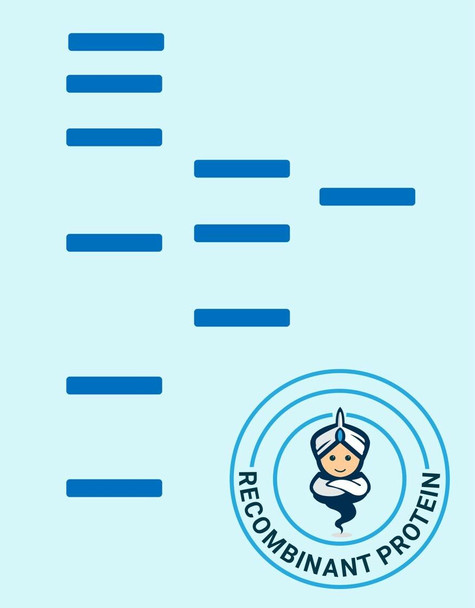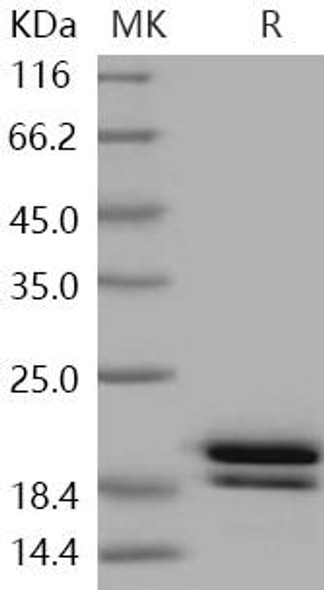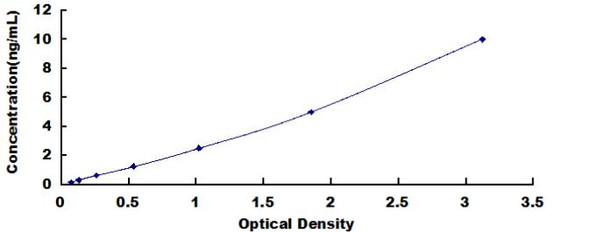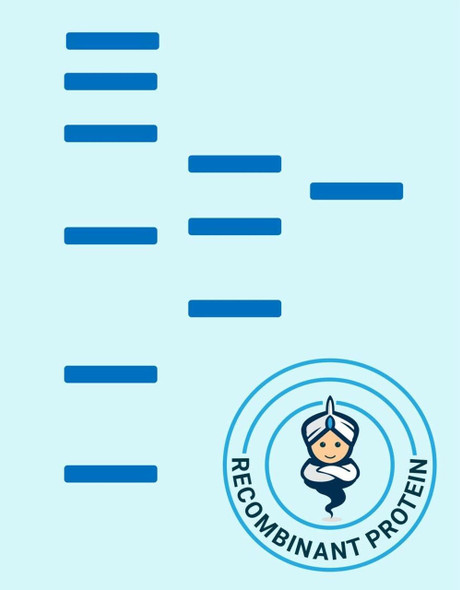Description
| Product Name: | Human REG1B Recombinant Protein |
| Product Code: | RPPB4436 |
| Size: | 10µg |
| Species: | Human |
| Target: | REG1B |
| Synonyms: | Lithostathine-1-beta, Regenerating protein I beta, REG1B, REGL. |
| Source: | Escherichia Coli |
| Physical Appearance: | Filtered White lyophilized (freeze-dried) powder. |
| Formulation: | Filtered (0.4�m) and lyophilized from 0.5 mg/ml in 20mM Tris, pH 8.0. |
| Solubility: | It is recommended to add deionized water to a working concentration approximately 0.5 mg/ml and let the lyophilized pellet dissolve completely. Product is not sterile! Please filter the product by appropriate sterile filter before using it in the cell culture. |
| Stability: | Store lyophilized protein at -20°C. Aliquot the product after reconstitution to avoid repeated freezing/thawing cycles. Reconstituted protein can be stored at 4°C for a limited period of time; it does not show any change after two weeks at 4°C. |
| Purity: | Greater than 95% as determined by SDS-PAGE. |
| Amino Acid Sequence: | MKHHHHHHAS HMQESQTELP NPRISCPEGT NAYRSYCYYF NEDPETWVDA DLYCQNMNSG NLVSVLTQAE GAFVASLIKE SSTDDSNVWI GLHDPKKNRR WHWSSGSLVS YKSWDTGSPS SANAGYCASL TSCSGFKKWK DESCEKKFSF VCKFKN |
Reg protein was shown to be stimulated during the regeneration of pancreatic islets. Since then, many Reg-related proteins have been identified in humans and other animals. In human, the four REG family genes, i.e., REG 1 alpha, REG 1 beta, REG-related sequence (RS) and HIP/PAP, have so far been isolated. These Reg-related proteins are classified into four subfamilies according to their amino-acid sequences, but they share a similar structure and physiological function. Reg protein is a growth factor for pancreatic beta cells and also suggests that the administration of Reg protein could be used as another therapeutic approach for diabetes mellitus. Human REG cDNA which encodes a 166-amino acid protein with a 22-amino acid signal peptide. The amino acid sequence of human REG protein has 68% homology to that of rat Reg protein.Reg I was found to be expressed mainly in pancreatic beta and acinoductular cells as well as gastric fundic enterochromaffin-like (ECL) cells. Reg I production in ECL cells is stimulated by gastrin, as well as by the proinflammatory cytokine, cytokine-induced neutrophil chemoattractant (CINC)-2Beta. In patients with chronic hypergastrinemia, Reg production is stimulated, with the increased proliferation of gastric mucosal cells. Patients with Helicobacter pylori infection also showed increased Reg production in the gastric mucosa, partly via increased plasma gastrin concentration and partly via increased proinflammatory cytokine production. The serum concentration of the reg-protein was significantly higher in patients with various pancreatic diseases than in normal controls, and was also significantly higher in patients with acute pancreatitis or chronic relapsing pancreatitis than in patients with chronic pancreatitis. Furthermore, the serum PSP/reg-protein concentration was also significantly increased in liver cirrhosis, choledocholithiasis, and various cancers of the digestive system.
The Recombinant Human REG 1 beta manufactured with N-terminal fusion of His Tag. The Human REG 1 beta His-Tagged Fusion Protein, produced in E. coli, is 17.8 kDa protein containing 144 amino acid residues of the Human REG 1 beta and 12 additional amino acid residues � His Tag (underlined).
| UniProt Protein Function: | REG1B: Might act as an inhibitor of spontaneous calcium carbonate precipitation. May be associated with neuronal sprouting in brain, and with brain and pancreas regeneration. |
| UniProt Protein Details: | Protein type:Secreted, signal peptide; Secreted Chromosomal Location of Human Ortholog: 2p12 Molecular Function:carbohydrate binding Biological Process: cell proliferation |
| NCBI Summary: | This gene is a type I subclass member of the Reg gene family. The Reg gene family is a multigene family grouped into four subclasses, types I, II, III and IV based on the primary structures of the encoded proteins. This gene encodes a protein secreted by the exocrine pancreas that is highly similar to the REG1A protein. The related REG1A protein is associated with islet cell regeneration and diabetogenesis, and may be involved in pancreatic lithogenesis. Reg family members REG1A, REGL, PAP and this gene are tandemly clustered on chromosome 2p12 and may have arisen from the same ancestral gene by gene duplication. [provided by RefSeq, Jul 2008] |
| UniProt Code: | P48304 |
| NCBI GenInfo Identifier: | 10835248 |
| NCBI Gene ID: | 5968 |
| NCBI Accession: | NP_006498 |
| UniProt Related Accession: | P48304 |
| Molecular Weight: | 16kDa |
| NCBI Full Name: | lithostathine-1-beta |
| NCBI Synonym Full Names: | regenerating family member 1 beta |
| NCBI Official Symbol: | REG1B�� |
| NCBI Official Synonym Symbols: | REGH; REGL; PSPS2; REGI-BETA�� |
| NCBI Protein Information: | lithostathine-1-beta |
| UniProt Protein Name: | Lithostathine-1-beta |
| UniProt Synonym Protein Names: | Pancreatic stone protein 2; PSP-2; Regenerating islet-derived protein 1-beta; REG-1-beta; Regenerating protein I beta |
| Protein Family: | Lithostathine |
| UniProt Gene Name: | REG1B�� |
| UniProt Entry Name: | REG1B_HUMAN |










